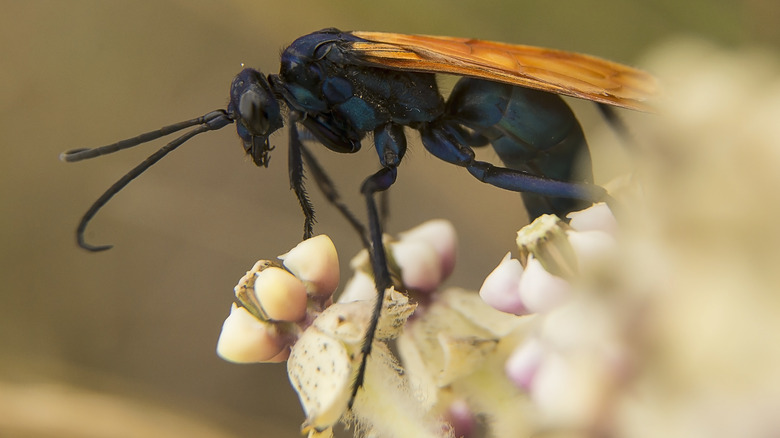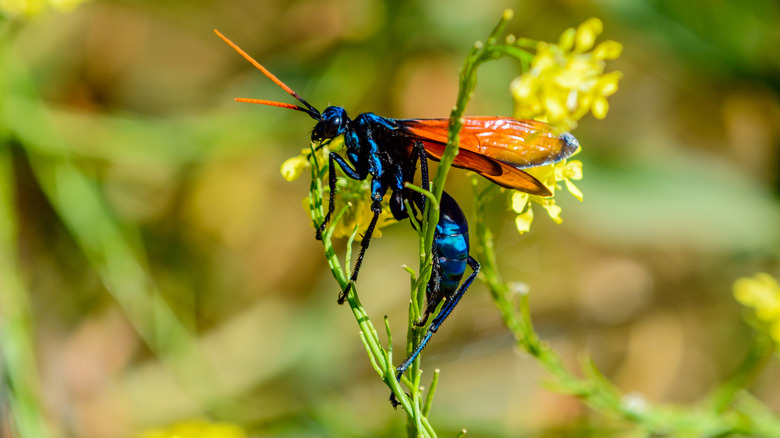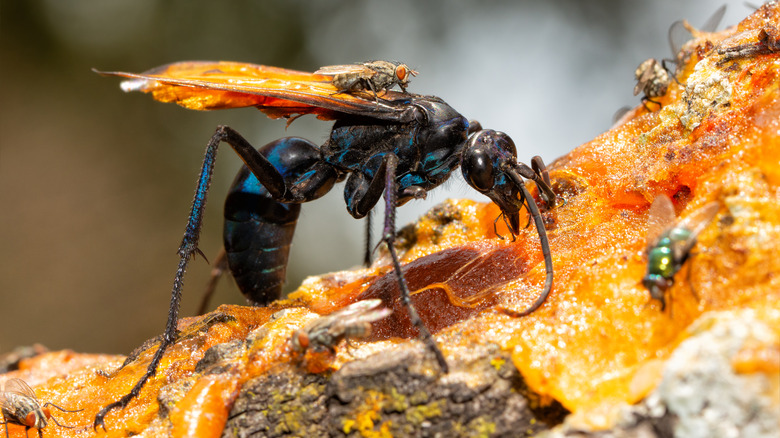An Entomology Expert Explains How To Identify And Get Rid Of Tarantula Hawk Wasps
You may not have known that tarantula hawk wasps are something to be on the lookout for, but if you live in desert areas of the United States, like Southern California, New Mexico, Texas, Arizona, and even up through Wyoming, then you most certainly should be aware of these insects. Entomologist at Mosquito Squad, Emma Grace Crumbley, spoke to House Digest exclusively and explained exactly what tarantula hawk wasps are, if they're dangerous, and how to remove and prevent their nests.
"Tarantula hawk wasps are large wasps native to the southwest United States," she said. "Known for their painful sting, these wasps are easily spotted by their dark blue, sometimes iridescent metallic body and orange wings." These wasps can get as big as 11 centimeters long, which is roughly as large as a hummingbird. Unlike other species, Crumbley notes you can expect to find tarantula hawk wasp nests in the ground or other natural crevices rather than made by leaves or hanging in trees.
"Aside from their colorations and extremely painful sting, tarantula hawks are also different from other wasps in their diets," said Crumbley. "Adult tarantula hawks are nectivores, meaning they primarily drink nectar from flowering plants." However, female tarantula hawk wasps will hunt tarantulas by paralyzing them with their venom and then dragging them to their nests, where they will lay eggs in the spider's abdomen for their larvae to feed on. Once the larvae emerge as adults, they lose their carnivorous appetite and go to a strict pollen and nectar diet.
Are tarantula hawk wasps dangerous?
Tarantula hawk wasps can be found on every continent aside from Europe and Antarctica, but to our relief, they're solitary wasps that don't form colonies. While stingers can be as long as 7 millimeters, only females can sting. You can identify males from females by looking at their antennae — a male will have straight antennae, while a female's will curl.
As for their sting, it's high-level. "According to the Schmidt sting pain index (created by entomologist and UGA Alumni Justin O. Schmidt), the tarantula hawk has the highest pain level on the scale: Pain Level 4, 'blinding, fierce, shockingly electric,'" explained Emma Grace Crumbley in an exclusive interview with House Digest. "Tarantula hawk stings are only second on this scale to the sting of South American bullet ants, and the pain from the wasp sting (though intense) only lasts around five minutes."
Due to the severity of their stings, the tarantula hawk has very few predators that disturb them, with roadrunners, bullfrogs, and the kingbird among that short list. A tarantula hawk's vibrant orange wings send a warning message to possible predators, known as an aposematic signal. Crumbley noted that although they can be a scary threat to people, they're important to our environment. Tarantula hawks are primary pollinators for desert plants like milkweed, which is essential to other insects like monarch butterflies.
If ever stung by these giant wasps, use cold compresses and topical medicines to help relieve any pain, swelling, and itching. Humans aren't at risk of experiencing paralysis as tarantulas are.
Removing and preventing tarantula hawk nests
According to entomologist Emma Grace Crumbley, since tarantula hawks form their nests in the ground, you'll want to look for any "burrows ranging from 1-2 inches in diameter." She also suggests inspecting natural openings in rocks, wood, and other yard items that could possibly be housing tarantula hawks. "To prevent these wasps from establishing near your lawn, keep a tidy yard space and identify potential nesting areas," said Crumbley, speaking exclusively to House Digest.
"In addition to wasp-proofing your lawn, check that your outdoor spaces are not harboring tarantulas. Again, keeping a clean lawn will discourage large spiders from moving in," she added. While a tarantula hawk is unlikely to bother you, it'll certainly attack if provoked or feels threatened in any capacity. So, it's always crucial to be aware of their presence on the off chance you accidentally disturb one.
"Unlike other insects which may lose their stinger (or only sting once), wasps can sting as many times as they want to ward off danger," Crumbley explained. "I do not recommend attacking tarantula hawk nests directly when trying to remove these wasps." Instead, consider hiring an exterminator if you have found a tarantula hawk nest on your property. While you can use insecticide dust and cover the nest's opening to kill off the wasp inside or apply a damp towel to the entrance to kill them with fumes, it'll always be safer to call a professional to handle the matter.


